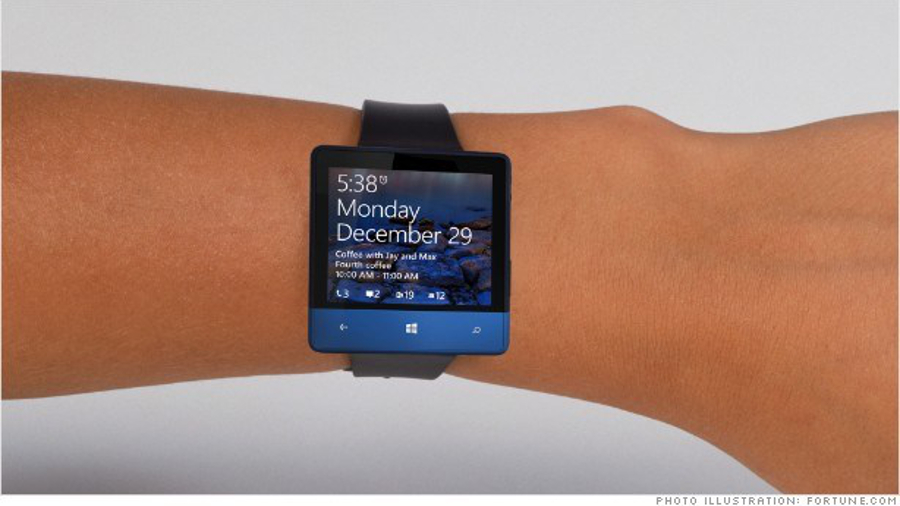Microsoft has laid the groundwork for a smartwatch with Windows 10
But will the device succeed?

The wearables space is, according to almost everyone in the industry, going to get pretty big, pretty soon. The Moto 360 offers one of the most compelling designs of any technological device released in the past few years and shows that the future is bright for "smartwatches" as they have come to be known.
- All you need to know about Windows 10
Samsung has devoted considerable resources to its watches – the Gear Fit, focused more on sport, and the Gear S, a more traditional watch – which raises the profile of the smartwatch space, getting them into the hands of consumers through bundles with the Galaxy line of phones and through Samsung's enormous advertising clout.
Apple has also given us a first look at the Apple Watch, which many industry observers – both of technology and, more importantly, of watches – have claimed is the first 'real' device to pay homage to a watch, offering versions fashioned from stainless steel and various karats of gold.
- Is the new OS any good? Read our hands on Windows 10 review to find out
Where's Microsoft?
The one company that has been noticeably absent from the conversation surrounding smartwatches is Microsoft. I've written previously that Microsoft could leverage the nascent nature of the smartwatch space – no clear winner has emerged, yet – to get a foothold in a new revenue stream and to claw back some cultural relevance. The Microsoft of 2014 is very different to the Microsoft of the 1990s, which was propping up Apple, having lost almost all relevance to consumers except in the rapidly decreasing PC and laptop space.
With the unveiling of Windows 10 – which wasn't, as many predicted, called Windows 9 – we may have a clue as to whether Microsoft will be releasing a smartwatch and, most importantly, when.
Windows 10 unveiled an all-too-familiar look for Windows, harking back to Windows 7. Unlike Apple, Microsoft is a firm that is incredibly interested in consumer feedback and shaping the company through the process of asking users what they want. Steve Jobs famously quipped that "people don't know what you want until you've showed them it". Microsoft has always taken the opposite route, showing and then iterating based on feedback from a small but influential group.
The majority of consumers who picked up a laptop with Windows 8 or upgraded from Windows 7 on their own PC likely didn't miss the Start menu, choosing instead to utilise the new tiled interface. A small, but vocal, majority did, however, and Microsoft was therefore abridged to reintroduce the Start menu, albeit modified to include tiles.
Are you a pro? Subscribe to our newsletter
Sign up to the TechRadar Pro newsletter to get all the top news, opinion, features and guidance your business needs to succeed!
One vision
What Microsoft also unveiled with Windows 10 was something that the company has been trying to introduce for years, and has only just now been able to: One Windows. The "One Windows" vision has been around since the time of the first version of Windows and essentially means that Windows runs across all devices.
Early on in Microsoft's existence this was possible as all devices were essentially desktop PCs. At one time, Microsoft controlled over 95% of the desktop and laptop PC market (ceding the remaining 5% to OS X and Linux), essentially creating a Windows-only world.
Nowadays, things are very different. The success of the iPhone, Android and iPad have meant that Microsoft can no longer lay claim to controlling over 90% of the world's internet devices. In fact, Windows Phone devices count for less than 5% of all smartphones currently on the market.
All devices great and small
According to Microsoft VP Joe Belfiore, Windows 10 can run on the smallest devices to the largest – anything from the Internet of Things to 80-inch TVs and everything in between. While it was only the desktop and laptop version of Windows 10 that was shown off at the recent press event – arguably the most relevant as most people will use this version – this subtle hint could encapsulate the future of Microsoft and will lead the way for wearables.
Max Slater-Robins has been writing about technology for nearly a decade at various outlets, covering the rise of the technology giants, trends in enterprise and SaaS companies, and much more besides. Originally from Suffolk, he currently lives in London and likes a good night out and walks in the countryside.